
Preppers are not new to bugging out or firearms. But what constitutes the best guns for bugging out?
Uncertain times continue. Portions of some cities resemble burned out war zones. Residents are leaving in droves. One wonders what would happen during some large-scale catastrophe with an entire population poised to flee. Suddenly, a bug out plan is no longer a fringe idea.
Where would you go? How do you get there? What do you bring for essentials? And, how do you defend these crucial items along with yourself and any loved ones?
If 911 services go kaput, security will require proactive strategies best reinforced by a firearm. Just about any gun is better than no gun. If necessary, I’d grab what I could get. But there’s a good chance it would be unsuitable for the subject at hand…
My 5 best guns for bugging out:
- Glock 17 9mm
- AR-15 9mm
- AR-15 16″ Carbine
- Ruger’s 10/22 Takedown Rifle
- Ruger’s .308 16″ Scout Rifle
There are solid reasons why I made each choice, and I will get to those reasons in detail, but it would be wise to set the stage for decision making. In other words, what goes into the factors that make up the best bug out guns? They are mission-specific choices, but at the same time, no bug out situation is the same. People have different needs, different situations, and thus, different plans. Let’s sort through all of that before the details of each gun selection.
Sorting Through the Choices
Good choices can offer advantages beyond pure defense. For example, let’s consider currency. If things turn ugly, cash may take a back seat to essential commodities. Food, ammunition, and fuel could become extremely valuable, which means they’d also have real bartering power. If you’re low on gas but have a high-demand caliber, a swap could be in the works. A box or two of 9mm rounds could give you more vehicle miles or produce more generator juice.
Speaking of ammunition, weight can be a critical concern on foot. Other items will be necessary and, as every seasoned vacationer knows, it’s easy to overpack. Life was a lot simpler in the heyday of western expansion, but even then, wagon trails became littered with jettisoned “essentials.”
But firearms, ammunition, knives, and tools remained close at hand, along with food and precious water. The latter two were considered renewables through the skills and fortune of the party. Traveling as a group imposed greater logistical hurdles but it improved the odds of reaching our destination. Today, this same strategy, or parts of it, has potential for bugging out.
Considerations
Consider defense a given, and subsistence hunting a possibility. The introduction of movement requires foresight.
Travel by Vehicle or On Foot?
A full G.I. ammo can is downright heavy but it’ll travel well in most vehicles. So will food and water and other sundries. A bug out backpack is an entirely different story since every ounce counts. Sounds like a fairly simple issue to sort out, right? Maybe, but don’t discount Murphy’s Law. What happens if your wheels quit spinning?
Vehicle
Hopefully, you can get those tires turning again. Otherwise, you’ll be facing hard choices with some eerily historic similarities. If lacking some type of bug out convoy, one or two modern trekkers won’t be able to lug a trunk full of guns or ammunition, let alone canned goods, water containers, and various “essentials.”
It’s worth development of Plan B just in case. You could hide or bury items in waterproof wrappings before setting off on foot, but that could take time. And, without an attainable destination, a trek on foot could become one-way.
I’d cross my fingers and stash several firearms in my vehicle. Among them would be a general-purpose AR-15 (details to follow), stowed for ready access with spare ammo. Nearby would be a pack containing essential items. If deployment on foot became necessary, beyond the AR, two or more passengers could field additional firearms. I’d also want a good defensive handgun.
On Foot
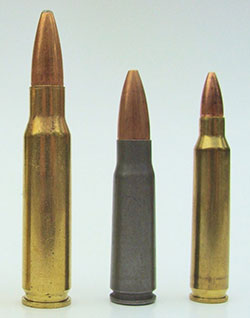
Since Roman times, the practical limit for travel on foot has been under 100 pounds for a young and fit soldier (60lbs or less for most others). I was a young, fit soldier years ago. The romantic vision of a fully-equipped pack and the reality of carrying one are quite different. The contents of a pack will be governed by harsh realities.
In my case, beyond miscellaneous items and food, carrying the gear required to deal with enemy threats competed heavily with water. The norm of 4 one-quart canteens was maddingly insufficient due to tropical heat and rough terrain. Bulk amounts of ammo was the other priority.
The compromise for our seven riflemen was a basic 5.56 load of approximately 300 rounds. They were carried cross-chest in bandoleers (meaning they weren’t part of the pack-load). This cartridge lacked the terminal effects of larger 7.62×51 NATO (.308) rounds, but it was adequate and could be carried in greater quantities. Two other members reinforced the squad with heavier weapons, but our goal was to remain undetected. We only had what we could carry so, in a very real sense, we were “bugging out.”
The above is shared only to illustrate two key points: (1) Additional people can provide firearm options, and (2) on foot, every item is a trade-off against overall weight. In addition to ammunition, food, and water, many of today’s so-called “essentials” run the gamut from lights to phones. Batteries and portable solar chargers could be part of the load, so if smaller and lighter cartridges can cover your needs, well, good enough.
Just remember, practical clothing is absolutely essential. A romp in a not-too-friendly great outdoors could drag on for days during conditions you’d normally avoid. If you get cold and wet but can’t dry out, you’re finished. You’ll need a system to make it work. That requires planning, and refinement through bug out practice-runs.
If your going solo, carrying more than one long gun will probably be impractical. You could pack a second takedown gun by sacrificing some space and weight, but is it worth the weight? Either way, I’d wear a holstered handgun. For some, it could be a compact model, to help minimize the burden. The long gun will require a sling. Choices abound but two-point slings are better than single-point for good reasons.
Will You Need Additional Food And Water?
Are you bringing all the food and water you’ll need, or do you plan on some foraging? Those on foot could be scrounging within a couple days, and you’ll need water before you need food. Case in point…
In what I refer to as “the bad old days,” with defense being a top priority, we got creative in the field. At that time, by happy coincidence, freeze-dried LRRP Rations appeared as a lightweight substitute for canned C-Rations. “LRRP” stood for Long Range Reconnaissance Patrol (which sorta fits the current topic). These rations were a welcome change, but like today’s freeze-dried entries, they used precious water.

We solved this dilemma by refilling empty canteens from mountain streams. A used C-Rat can was transformed into a stove by punching holes through its bottom. Our fuel was a pinky-sized blob of C-4 plastic explosive placed under the inverted can. Once lit by a cigarette, the high-energy inferno would boil a full canteen cup within seconds. Viola, hot chicken stew or spaghetti, more potable water, and no telltale smoke. Today’s smokeless fuel tablets should work in a similar manner, leaving precious pack room for other essentials.
Eventually, subsistence hunting could become of prolonged bug outs. The logical quarry becomes small animals or birds, whether game species or not. In bygone years, blackbirds (as in blackbird pie) were a common staple, collected with smaller calibers (or shot pellets). This method damaged less meat and was generally quieter. Conventional big game calibers (.308, etc.) will blow a grouse to smithereens and can be heard for miles. Even if suppressed, most high-powered rifles, including a .223, are as loud as a high-speed .22 LR. For some, although marginal for defense, a .22 could prove valuable.
What is Your Terrain?
Will you be traveling through open country or forested areas? This question relates to both defense and the habitat of huntable critters.

Open Country In the vast open expanses of the western U.S., a longer-range rifle makes sense, both defensively, and for hunting. For defensive purposes, a properly configured AR-15 (chambered for .223/5.56) should be good for at least 400 yards. It’ll also cover most hunting needs, especially if larger animals like elk are off the list. With the right loads and careful shooting though, a .223 can take deer and hogs. For that matter, a well-placed head-shot will kill about anything that walks. Still, something on the run will want a heavier caliber.
Forested Areas In my northern New England region the terrain is just the opposite. Because it’s heavily forested, most of our big game (deer, black bear, moose) are taken well inside 100 yards. Flat-shooting calibers are less in demand and plenty of .30-30 lever-guns are still used throughout the woods.

Lots of other species are taken at shorter ranges with .22 rifles or shotguns; everything from small game through turkeys, along with upland birds and waterfowl. It’s safe to assume all, including moose, have been poached with .22 rifles. So, if necessary, a pistol-caliber carbine (in 9mm or .38/.357) could suffice while also covering defense – and either is ideal for a suppressor.
This ground you cover, the anticipated need for defense and food, and overall weight are all factors that will impact your choices on the best guns for bugging out. Also ask…
What is Your Bug Out Destination?
Are you headed toward a prepared location, one with cached essentials, or are you dependent on what you can transport?
Prepared Destination An attainable, prepped location changes everything for the better. If you have a bug out location equipped for longer-term habitation, options expand on all fronts from defense through subsistence. Your interim travel load can decrease.
But is your bug out location as secure as you think it is? Upon arrival, larger, pre-positioned calibers can support increased hunting opportunities. Methods for meat preservation can be developed or refined. Meanwhile, the location can be defended and reinforced.
Oscar Mike (on the move) Things become tougher without a finite destination. Days could turn into weeks. Any tarp versus tent bug out shelter debate could become moot as the desire for more serious housing grows. Clandestine travel could also become necessary in addition to subsistence hunting. Beyond pack weight, noise could be a concern. If in that situation, I’d trade maximum defensive capability for long-term survivability. Taken to the extreme, that .22 LR comes to mind. And again, to back it up, I’d want a handgun on my person.
Bug Out Firearm Guidelines
Although most serious preppers already own some of the best guns for survival, others could be starting from scratch. A big problem for the latter group is, depending on current events, gun shops could have meager inventories, particularly for ammunition.
Still, an educated purchase is safer than an impulse buy. User-friendly firearms can greatly simplify the learning curve to help develop proficiency. If you are just getting started, consider reading my book Survival Guns: A Beginner’s Guide.
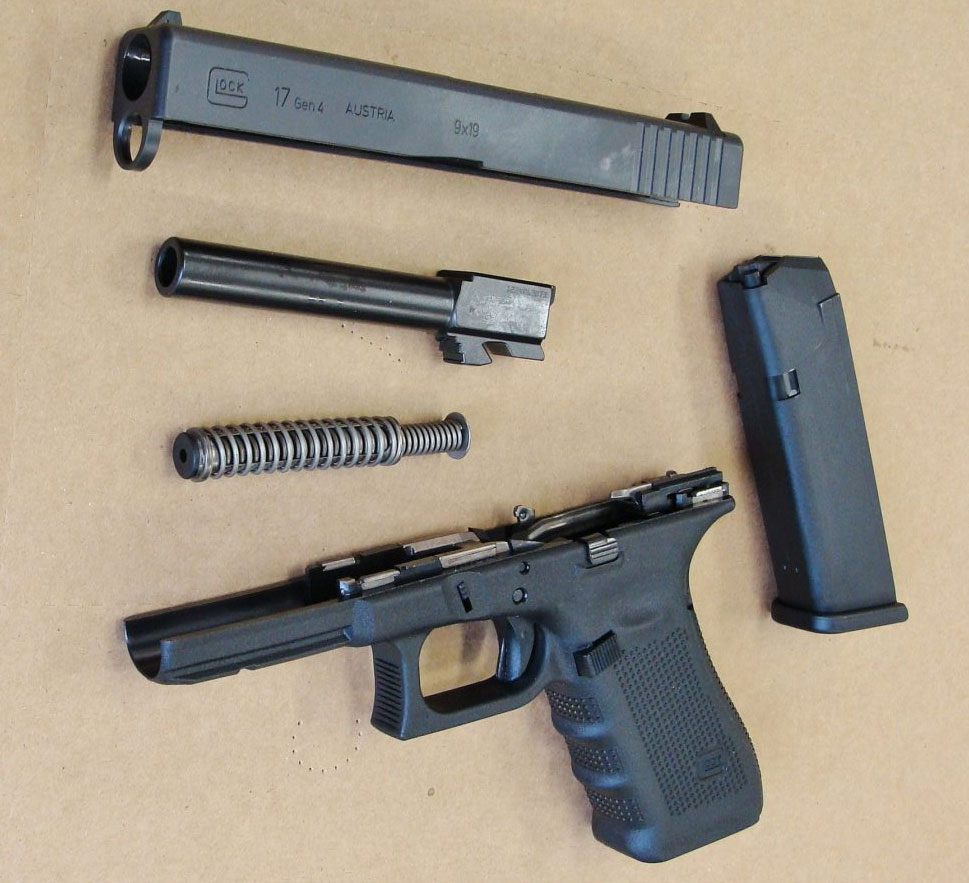
Bug out firearm concerns involve reliability and ease of maintenance. Quick disassembly and captive parts will help when on the go. A spring-loaded guide rod that launches to parts unknown is bad enough in daylight let alone around a campfire in snow. Popular firearm choices also improve availability of parts and accessories, especially if normal support channels dry up. This also includes ammunition!
Ammunition
At the moment, common calibers (and increasingly others) are flying off retail shelves. The hottest-sellers are .22 LR, .223/5.56mm, 7.62×39 Russian, 9mm, and .45 ACP (along with .380 ACP). The larger 7.62×51 NATO (.308 Win) and 7.62×54 rifle cartridges are also in demand due to their military lineages. Beyond cost, their downside is less rounds per pound. This is also true of the time-proven .45 ACP. Although effective, a box of fifty weighs twice that of 9mm.
Fortunately, the nine’s effectiveness has greatly improved through better bullets. The recent return of LE agencies to the 9mm is even killing off the .40 S&W. Ironically, its shaky 10mm parent has been resurrected to provide greater semiautomatic pistol power. It’s a great cartridge, as is the .41 Magnum of around the same power, but nowhere near as common as the ubiquitous 9mm Luger. Since the goal here is to stick with widespread calibers, the focus will be on .22 LR, .223/5.56mm, 9mm Luger and, for some, the .308/7.62×51 NATO.
Optics
Today’s electronic dot-sights are popular for good reasons. They’re both fast and intuitive, accounting for their widespread military and law enforcement use. Several years ago I procured a large quantity of Aimpoint PRO Patrol optics for my agency. Important for us, their 30mm tubes permitted attachment of lens caps for use during rain and snow. They’re relatively lightweight and compact, making them well-suited to bug out situations, whether on foot or by vehicle.
We mounted them to AR-15s configured similarly to military M-4s, and backed them up with co-witnessed folding rear sights. These Aimpoints are still going strong and their battery life is phenomenal, but the reticle (aiming-point) will disappear without power. This is also true of the latest miniaturized red-dot sights now seen on handguns. Optics should be equipped with lens caps.
Rifles and AR-type Pistols
Good ‘ol iron sights are weatherproof and rugged. Two downsides are (1) they’re hard to use in low light, and (2) most users will require a personalized zero. The right optical choice can solve these issues, especially if it reticle is always “on.”
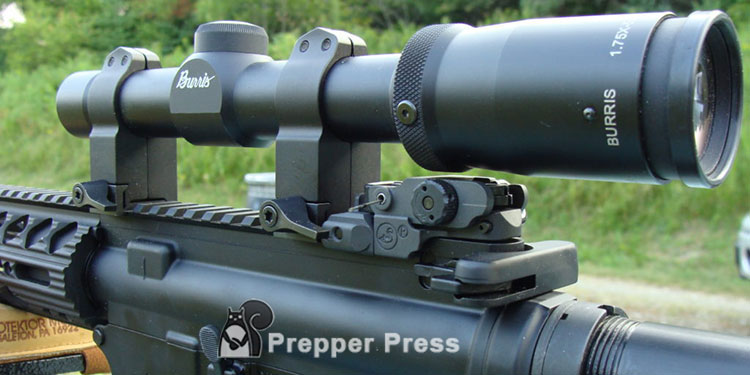
As it turns out, a smaller high-quality variable scope in the 1-4X range fits this description well. Its large field of view will permit rapid target acquisition on the lowest setting. If equipped with an illuminated reticle the net effect is similar to a dot-sight, with the advantage of greater precision for use on smaller targets.
These scopes are typically compact and smaller than dot-sight/magnifier combinations. Another advantage is their ability to accommodate weatherproof lens caps. If the illuminated feature fails or batteries dry up, you’ll still have a useful reticle.
Worst case, if mounted in QD rings, they can be removed and backed up by iron sights. A folding rear sight like the ARMS40L will tuck under many ocular housings, and both systems will mount nicely to an AR-15 (or some bolt-actions, etc.). In my experience Warne’s QD rings will hold their zeros throughout multiple mountings.
Handguns
The small miniature red-dot sights are now practical enough for daily carry, but those (nowadays most) mounted to pistol slides do lead a harder life. Some need to be removed for a battery replacement – usually with the need to re-zero afterward. A set of backup irons that’ll co-witness through the optic is thus worthwhile.
Seems like few discuss bad weather, but two evenings ago, I was attempting to fill a bonus doe tag with my S&W Model 629 revolver. It’s frame-mounted MRDS can withstand .44 Magnum recoil and immersion, but I spent much time trying to keep a bout of unexpected rain from spattering the lens surfaces. An alternate KISS strategy is a set of Tritium-powered night sights that’ll work in all light and weather conditions. The Keep It Simple Stupid approach is particularly beneficial in a bug out.
System Cost
The well-known rule of thumb is to buy the best equipment you can afford. However, when it comes to firearms, “equipment” means more than just a gun. With a handgun alone, the basic extras will include a holster, magazine or loader pouch, ammo, and a few spare magazines or speed-loaders. Adding up the essentials (with extra room for training), constitutes the bottom line. We call this our “system cost,” which can mushroom without educated planning.
If you are expanding this “system cost” to an overall bug out “system,” don’t forget that you will still have plenty of other gear to get, including firestarter equipment, bug out cookware, and more.
The Five Best Guns for Bugging Out
Okay, hopefully I’ve kept your attention this far. Now it’s time to look at the best guns for bugging out, starting with one universal necessity – a handgun. The appearance of a long gun could raise alarms, but most service-type semiautomatic pistols (or revolvers) can be easily concealed. As long as you have one on your person you’ll have a constant means for defense. The others listed below are more of a menu. Pick and choose to suit your needs.
A word on pricing: Beyond firearm scarcities, unprecedented demands have elevated some costs. The situation is volatile enough to render some pricing useless; the reason they’re not shown below.
#1 – Glock 17 9mm Pistol
I have a long history with the 1911 Government Model and really like S&W’s M&P pistols, but the success of the Glock is irrefutable. Beyond its dead-nuts reliability and easy disassembly for cleaning, magazines are everywhere.
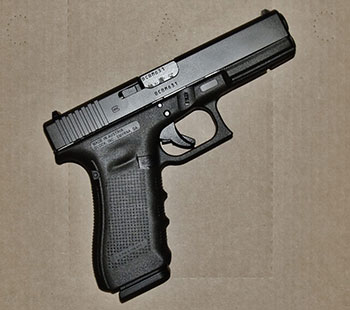
A 9mm Glock 17 offers an advantage recognized by 19th century western settlers who lived on the edge of civilization; namely a common-caliber handgun and carbine. The latter was typically a lever-action that fired revolver cartridges (still a viable combination).
Today’s equivalent is a 9mm AR configured as a carbine or pistol, capable of using Glock magazines. The standard is 17 rounds but they come even larger. Place two more in pouches and you’ll have more than a box – not to mention the numerous higher-cap versions.
Fully loaded, a Glock 17 weighs around 32 ounces. That fact, combined with its concealability and common caliber, make it land at the top of the best guns for bugging out list.
Although now in its 5th generation, previous examples can be found. The newest have interchangeable grips to improve fit. Those more interested in just a handgun, or a smaller type, will find other useful Glock models in various sizes and calibers. The smallest versions hide very well but still work like the Glock 17. On top of that they’re normally affordable pistols.
Some may choose to end their choice of the best guns for bugging out right here. If so, good enough. But a handgun does have drawbacks. Primarily, it’s just a difficult firearm for most users to master. This limits its practical use to fairly close-range defensive purposes. Although much more shootable, a carbine would be a challenge to hide. But, what if you could feed it from the same box of ammo, and squeeze it in your pack? The next choice is compact as is – and, we can make it even smaller.
#2 – AR-15 9mm, 8 – 10 ½-inch Pistol (or 16” Carbine)
I’d skip this choice in big sky country, but elsewhere it has serious merit. For starters, logistics are greatly simplified through use of a single caliber, especially if the cartridges are relatively portable 9mms. If you have a 9mm Glock and an AR-15 in 9mm, you only need to carry one type of ammunition. And there are advantages 9mm ARs have over handguns of the same chambering, including improved accuracy, greater range, and a boost in velocity.
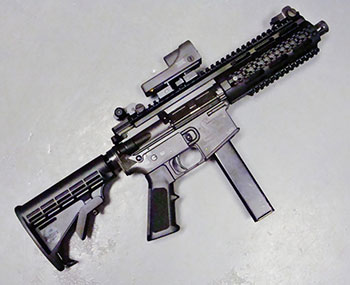
Many of today’s so-called pistol braces can provide the stability of a short-barreled rifle (SBR) without the need for a $200 Federal stamp (at least, that’s the situation at the moment). Also, 8-10 ½” barrels will burn just about all of a 9mm’s propellant.
A 16″ carbine won’t increase velocity by a huge amount, although some hot +P loads can add 10%. However, either length is quieter than a 4-inch pistol, and the report of a 16” carbine is closer to a .22 LR.
If seeking maximum noise reduction, a threaded AR muzzle is great for suppressors. They work perfectly if you need to nail small to mid-sized game without making a big bang. There are countless bug out situations that could require ballistic power and noise reduction.
Popular 147-grain subsonic loads will hit hard without a telltale sonic crack. Even with a “can” attached, overall length of a 10 ½” AR will be similar to a 16-inch carbine. Most of my 9mm AR experience involves shorter 7” sub-gun versions equipped with Trijicon Reflex dot sights.
Although controllable on full-auto, deliberate semiauto shots were the norm. In this mode, hits were a cinch on smallish combat silhouettes out to 100 yards – and beyond. Although doable with practice, 200-yards is a stretch. In light of that a dot-sight does seem “right” on a 9mm AR. An Aimpoint Pro (backed up by folding irons) would work, although trickier small game shots could pose challenges. Meanwhile, while awaiting the dreaded apocalypse, you’d have a darned effective home or bug out location defense gun!
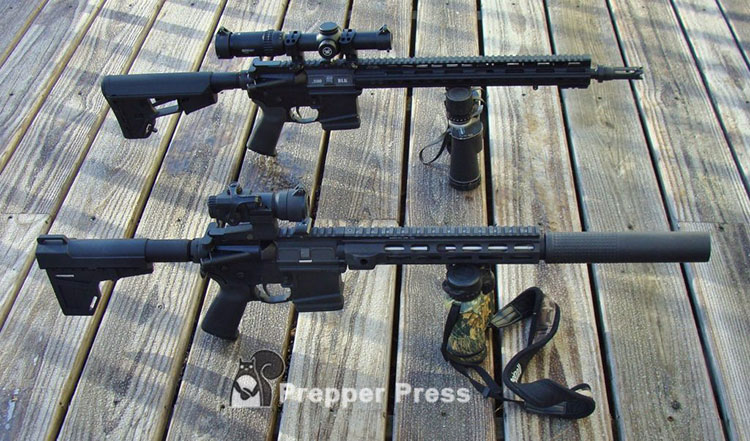
For use afield though, if using a small scope zeroed at 50 yards, the accuracy is there to pot rabbits, grouse, etc. with non-destructive 9mm FMJs (Leupold’s 1.5-4X Freedom has real possibilities). A switch to good expanding JHPs will cover defense and larger critters. If necessary, I’d use this 9mm system on deer, shooting carefully with an expanding solid-copper load like that sold by Barnes. Stick with a common weight and one zero will often work. Color-coded magazine can help keep them segregated.
If you’re utilizing both a Glock 17 and a 9mm AR, you now have the added benefit of using the same ammo and the same magazines. Just be aware that some Glock-based 9mm ARs don’t incorporate a last-shot lock-back. This feature requires extra engineering, but to me it’s worthwhile.
Until recently, the majority of 9mms ran off standard AR lowers, converted to accept Uzi magazines. But the nearly universal 9mm departure is omission of an AR’s normal gas system. Instead, function occurs through a simplified heavy blow-back bolt. For the most part though, the well-established AR lineage is preserved.

Maintenance is easy with any AR, but the 9s are especially simple. Unlike a standard 5.56 design, there is no bolt-carrier and separate bolt. Pop the rear push-pin and the upper receiver will swing open, permitting removal of its large one-piece bolt. From there, like all other ARs, things get even better. Retract the forward pin and both halves will separate. Viola, instant takedown!
My 10 ½” upper is the longer of two halves, and it measures 21-inches to the end of its flash-hider. It’ll stow within a fairly small space; a trick that could come in handy if a bug out was ever necessary through a populated area.
A 9mm AR carbine or pistol could be a good fit for many, but it can’t cover every contingency. Its downsides are shorter-range and punch, compared to true rifle calibers. The 9mm carbine concept was really catching on, but right now, those designed around true ARs are hard to find. Some more available versions are actually facsimiles with different internals and features.
#3 – AR-15 16″ Carbine .223/5.56 NATO
Here’s the general-purpose pick. Whether stowed in a vehicle or carried afoot, it should cover most needs out to a quarter-mile or so for those that have the skills to make it happen. Some people choose NFA-regulated 5.56 SBRs or AR pistols, but their velocity loss is significant. Also, unless suppressed, they’re really loud!
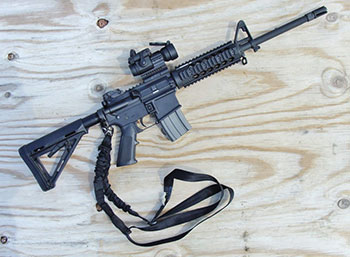
A standard 16” carbine is a fair compromise of handiness and power, with enough velocity for a flatter trajectory and better terminal effects. The popular 1:8 twist will handle many good loads, as will a 1:9. Heavier bullets are now in vogue but some good 55-grain choices exist that will work off an FMJ zero. Sight in at 50 yards and you’ll also be on the money at 200 yards. This should easily meet the needs for bugging out.
The 55-grain FMJs are good for more than practice; they can also take smaller game. Federal’s 55-grain Ballistic-Tips will hammer big coyotes and it’s also used by some LE agencies. Barnes VOR-TX solid coppers behave like heavier conventional bullets, combining expansion with deep penetration. They’re my choice for deer or hogs, etc. All three loads should print fairly close groups from one common zero. Read more on the ballistics of M855/M193/.223 alternatives.
Today’s, standard magazines hold 30 rounds. Some locales will restrict this to 10-shot types, however from properly located pouches, reloads will still be fast. Just about anyone should be able to carry several of ‘em, along with a generous reserve in a pack.
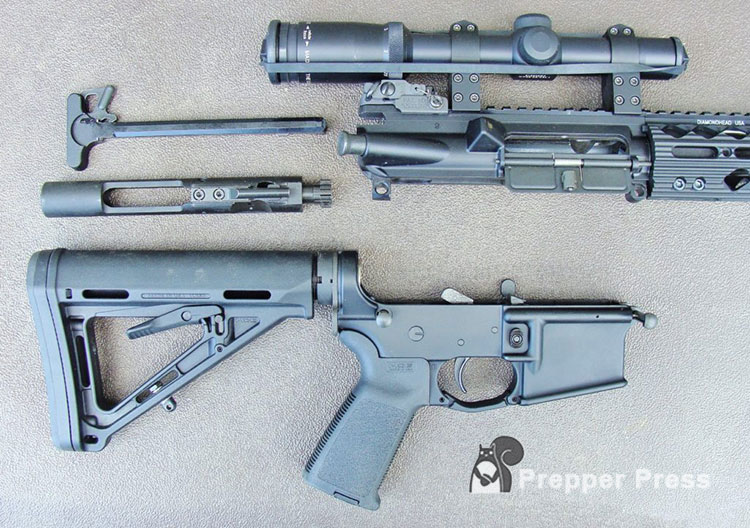
Let your bug out plan (and budget) drive your choice in optics. Leupold’s previously mentioned 1.5-4X Freedom Scope offers a compact solution. The version with a Pig-Plex Reticle even incorporates ballistic reference points. It’s a non-illuminated one-inch model, but cost is a reasonable at around $250. Another scope I’ve used during day and night conditions is the somewhat larger 30mm-tube Vortex 1-6X Strike Eagle. It’s reticle is a similar etched design which can also be illuminated. Mine is mounted in Warne QD rings, backed up with folding iron sights. I switch it regularly with a night-scope while maintain close zero.
The same ammo segregation tricks will work. Cleaning and disassembly are also similar. Once separated, a longer 16-inch upper-receiver assembly measures around 26-inches. This is a bonus if space is precious in a bug out vehicle or pack. If need be, you can also drop on a different one for an instant caliber conversion. I’ve done this often when switching to .300 Blackout, which is another great choice for those into suppressors. It’s downside? Although popular, .300 BLK ammo is less common than .223/5.56.
There are a number of decent ARs to choose from. With apologies to plenty of others, two makes I’ve had good luck with come from Rock River Arms and Windham Weaponry.
#4 – Ruger’s .22 LR 10/22 Takedown Rifle
This one is an INCH Bag pick (I’m Never Coming Home). Ruger’s semiautomatic 10/22 has been around for decades and remains hugely popular. New models still appear, including innovative takedown types ideal for survival purposes. Depress a small release and a simple twist will separate the barrel from the receiver, permitting storage within small spaces.
Almost tailor-made for bug out purposes is Ruger’s lightweight Model 31152. It’s fitted with MAGPUL’s X-22 Backpacker Stock, designed to stow three spare mags (the rifle ships with four). Once disassembled, if traveling on foot, the entire rifle (or half of it), could slip inside someone’s pack. If need be, a brick of ten .22 LR boxes (along with the rifle) could be shared to save weight.

Strange as it may sound, I’d seriously consider such a rimfire as my sole long-gun – assuming I was facing a prolonged one-way trek without a final destination. A 500-round brick of .22 LR rounds could last a very long time. Although far from an ideal defensive choice, a swarm of well-aimed .22 bees would be something to avoid. And, some of today’s high-velocity HPs are as flat-shooting as most centerfire pistol loads. If zeroed at 50 yards, they’ll only drop around 6-inches at 100 yards.
The Ruger’s 16-inch barrel is also long enough to yield near-maximum velocity. It’s capped by a threaded 1/2×28 muzzle common to rimfire (and 5.56) suppressors. If entering the world of silencers, another option is Ruger’s integrally-suppressed accessory barrel. It installs as easily as the original, but does require an NFA $200 silencer stamp.

.22 Bug Out Ammo Choices
The .22 becomes one of the best guns for bugging out in large part due to the ammunition itself. You can carry much more of it from its small size and low weight, it’s affordable, and it can keep you fed through dispatching small game. It’s perfect for quietly hunting squirrels if they need to keep you fed while on the move.
The more affordable, but still-stealthy alternative, is a switch to quiet .22 specialty loads. Shorts and CB Caps are extremely quiet but they can be difficult to load in some repeating actions like the Rugers. They also won’t feed through 10/22 magazines. The solution is .22 LR CCI Quiet-22s. Its report is reduced by less propellant, which lowers velocity to around 710 fps. However, the standard-weight 40-grain bullet still retains enough energy to take small game like squirrels out to 25-30 yards or so.
If zeroed at 50-yards with standard .22 LR loads (1100 fps), Quiet-22s will strike about 1 ½” low at 25 yards. I can compensate for this using a basic 3-9 scope. If set on 9X, the new 25-yard “crosshair” becomes the tip of the reticle’s lower duplex post. If I dial the magnification down to 3X this trick works at 50 yards. The original CCI Quiets lacked the oomph to cycle a 10/22 but a newer version supposedly will (if not, you can manually cycle the bolt).
As for conventional .22 LR loads, I’d let the rifle narrow down a few good finalists via 50-yard benchrest testing. Two loads worth trying are CCI Velocitors and Mini-Mags. Unlike most hyper-velocity lightweights, the Velocitors fire 40-grain HP bullets. Advertised at 1435 fps, they offer a rung up the .22 LR power-ladder for use on larger critters (or threats).
Rated for 1260 fps, the 36-grain Mini-Mags behave similarly to other high-speed types but often shoot well in Rugers. The various subsonic HPs are quieter and less destructive on small game. There are plenty of other good choices, too. Regarding accuracy, each rifle has its own preferences so the proof is in the shooting.
Optic Choices
This Ruger’s barrel is equipped with open sights, which could suffice for ardent bug out minimalists. But, the included scope base will help stretch its range. The quality of the scope should depend upon the rimfire’s role. If defense is factored in, once again, I’d consider a Leupold Freedom 1.5-4X with a Pig-Plex reticle, or something similar.
A scope and its mounting system add more weight so a conservative choice makes more sense. After all, you’ll need to factor in more ounces for ammo, extra magazines and a sling! But you’ll be off to a good start because this particular Ruger weighs a feathery 4.2 pounds, unloaded. It lists for $529.
Again, the Ruger 10/22 Takedown‘s downsides are marginal defensive capabilities and poor effectiveness on larger game. Hence, the following…
#5 – Ruger’s .308 16″ Scout Rifle
Cooper’s Scout Rifle may have predated the prepper movement but the concept fits it well. The well-known firearms authority, Jeff Cooper, pitched the idea of fielding a handy and reliable survival-type rifle with enough power and range to cover most contingencies – including a prolonged trek in rough country.
The resulting compact bolt-action fired readily available .308 rounds from a detachable 10-round magazine. A compact intermediate eye-relief, low-magnification (pistol-type) scope was mounted ahead of the action, which improved peripheral vision. For extra insurance the optic was backed up by a peep-sight system.

Ruger’s latest Scout Rifle is built on their time-proven M-77 action, and it pretty much nails this design.
Being a bolt-action, it’s also more PC than an AR. However, this Ruger does take common AIC magazines. It will also function with a wide variety of loads including “reduced-recoil” and subsonic types. The muzzle is threaded in the 5/8×24 pattern common to .30-caliber suppressors. It also has a preinstalled flash-hider; a useful feature due to the short barrel.
The .308 is hugely popular so plenty of great loads exist, and they will all function in a bolt action, giving this rifle an advantage of semi-auto counterparts. Choose carefully and you should be able to cover just about anything in the Lower Forty-Eight. Again, the homogenous copper bullets (from Barnes and Hornady, etc.) can up the ante by combining expansion with great penetration, but even plainer conventional types will work for deer or black bear, etc. If necessary, the chamber will also digest military 7.62×51 NATO rounds.
The Ruger Scout ships with an iron-sighted BUIS system, a forward-mounted rail, and scope rings. The Burris 2.75X Scout Scope, or Leupold’s 1.5-4 Freedom version, would be practical and affordable picks. Another option; by removing the rear sight, you can mount a conventional scope on the receiver (Ruger rings usually repeat zero). Optimal eye-relief can be achieved through the stock’s adjustable length. Of the several models available, the stainless/synthetic-stock version is the most weatherproof. OAL is 38” and weight is 6.2 lbs. It lists for $1200.
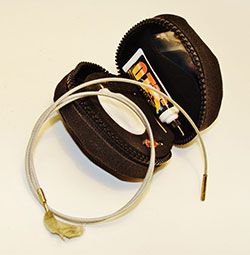
Accessories
A holster, magazines, and pouches constitute standard handgun gear. You’ll also need a cleaning kit. Although a rigid rod is required to clear an obstructed bore, a flexible pull-through system like an Otis is much more portable.
Long guns will need slings, and even a basic nylon type will work with QD swivels. ARs can benefit from a wide variety of good options including the previously mentioned two-point types.
Other Good Choices
No doubt plenty of experienced gun people will list entirely different picks for bugging out, and they’ll have some darned good reasons. That’s part of the fun of creating a list, the discussion itself!
.357 Magnum. Some will disagree with the pistol choice (at the moment I don’t even own a Glock). For that matter, a good double-action .357 Magnum revolver such as S&W’s Model 66 could be the perfect rough-country bug out gun.
Lever Action .357 Carbine. This carbine is a natural revolver companion that can significantly boost velocity. Go that route and you can scrap a 9mm AR for the PC alternative.
Other 9mm Choices. Meanwhile, some 9mm fans will be after Ruger’s clever new 9mm takedown carbine with modular pistol-mag options. There’s also KELTEC’s folding 9mm SUB2000.
30-30 Classic. If more power is called for, a Winchester .30/30 Model 94 lever gun can still do the job out to 200 yards or so. If you happen to have one, it could stand in for both the 5.56 AR and .308 bolt-action. If only they made a 30/30 AR-15.
Survival Rimfire. As for rimfires, the AR-7 was the original .22 LR survival gun. It even floats when disassembled when the action is stowed in its stock.
12 Gauge Pump. Looking for one do-all firearm? How about a 12 gauge shotgun? A Remington M-870 or Mossberg pump gun could cover nearly all needs by itself, especially with a spare slug barrel. Add one and you can tackle everything from vehicles to moose within 100 yards. Ammo weight is the only reason a shotgun didn’t earn a top spot. But, if I could only own one gun, this one would be it.
What are your choices for the best guns for bugging out and why? Let us know in the comments section.

5 comments
there is a MAJOR issue with trading guns ammo and food
1 IF you are on your own and walking from one town to another BAD GUYS will hear about what you have
if you are in a town with like minded people who are willing to stand and defend against attacks you had better have a whole warehouse full of guns and ammo and the people to use em same goes for food
because bad guys WILL HEAR ABOUT WHAT YOU HAVE and they will come to try to take it it would be far better to trade something like knives swords machetes or axes and IF it right down to it blades are NOT that hard to make GOOD TOUGH high quality blades that can take serious abuse are a another story IF you have a good black smith in your group thats a whole story
10mm handgun, your pistol is the gun you will ALWAYS have on you. It MUST be able to handle whatever is thrown at it. Man, or beast. 45acp has lousy penetration so it’s out.
A 308 ar, 556 is fine till you are in the woods and a top of the food chain predator shows up. Survival gun, must be up to the job under the worst case.
22mag pistol, bag gun for when you need small game. You will not be killing a moose everyday for food. kel tec pmr 30 is called by them, The plastic fantastic jam-o-matic. Walter WMP is a 22mag that works.
I prefer a semi-auto .308 such as the FAL or AR-10, either cover the high power, short, medium, or long range needs. While I’m not knocking the .223 option, I feel it’s not needed. Yes, the ammo is lighter but is it really saving you any weight if you have to carry both .308 AND .223? I think the 10/22 (or similar, like a revolver which aren’t finiky about ammo, esp. sub-sonic rounds) is a absolute necessity. I prefer a .357 mag. revolver (GP100) because 1) I shoot well with it and 2) knock-down power is undeniable, 3) it uses both .38sp. and .357 mag., both very common calibers and isn’t finicky with different brands, 4) disassembly for cleaning isn’t needed so loosing a small part while cleaning probably won’t happen. I think a 12 gauge shotgun would be a good choice if you’ll mostly be in heavily wooded areas, but the low quantity of ammo you can carry makes that somewhat iffy. Last, you might want to consider a combo gun like the Savage model 42, a .22LR over a .410, small game (including birds aflight) covered, though it wouldn’t be my first choice for self-defense (though 3 inch 000 buck is nasty) and it lacks a long-range/big game punch! I wish I could find a Balkai over/under in 12ga./.308 or even better an American-made combo gun in those or similar calibers, and with the addition of a .22LR barrel insert for the 12ga. barrel, this would be the closest thing to a perfect bug-out weapon possible IMHO!
I have a Glock 19 and a Ruger 10/22 Takedown. I also have attitude. Hope none of the three will be needed but…….
With my physical disabilities I am at a disadvantage as to how much I can carry, one thing I did do was have my vehicle fully armored and a second fuel tank installed. I am old school Army and my choice for a hand gun is a .45 ACP, my secondary choice is a .45 Colt revolver with a 6 inch barrel one I found that was a good buy and interesting configuration allowed my changing the standard cylinder to a 45 Cap and Ball should regular ammunition no longer be available. For a long gun I also like the .45 colt lever action with 7+1 load. I do have a decent Mosin Nagunt 7.62x54r with a 20x40mm Graduated Scale scope fitted and Zeroed out to 800 meters. Food wise again my Army time comes into play, MRE’s are light and easy to set up and eat. Water two cantines and a medium size bottle of water purification tablets, tastes like crap but keeps you hydrated. Since I will be driving my vehicle is always parked in a faraday equipped Garage, spare battery, and computer system and alternator as well spare serpentine belts four spare ones, and a good tool kit. I may be going a bit over board on somethings but I value my life over any punk or thug.